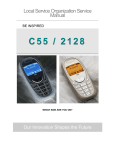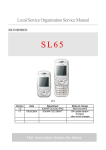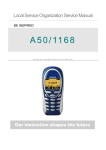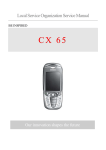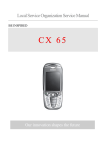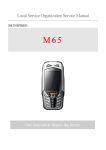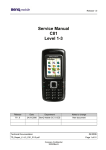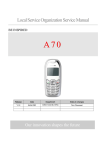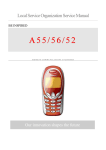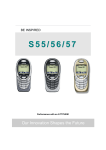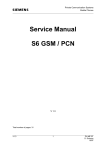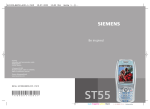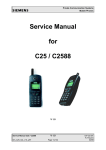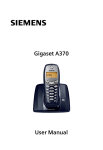Download Siemens CF62 Leopard Service manual
Transcript
SIEMENS CF62 Level 2 Service Manual BE INSPIRED CF62 Leopard Clean & distinctive design Copyright © Siemens Mobile All rights reserved 1 of 42 SSMC MD CCQ Internal Service Use Only Siemenes Shanghai Technical Support Center SIEMENS CF62 Level 2 Service Manual Table of Content 1 Cellular Communication ……………………………………………………….. 3 1.1 Coverage Concept ………………………………………………………… 3 1.2 GSM Network Architecture ……………………………………………… 4 1.3 Subscriber Identity Module ……………………………………………… 5 1.4 WAP ( Wireless Application Protocol )………………………………….. 6 1.5 GPRS (GENERAL PACKET RADIO SERVICE) …………………….. 7 1.6 K-JAVA APPLICATION ……………………………………………….. 8 2 CF62 Technical Information …………………………………………….………9 2.1 Key Features ………………………………………………………………9 2.2 Comparison With Previous Products ……………………………………10 3 Accessories……………………………………………………………………….. 11 4 Unit Description CF62 Leopard .............................................................……12 4.1 Assembling concept for the customer .................................................. 12 4.2 Interface CF62 Leopard to accessories ……………………...…………. 12 4.3 Exploded view of CF62 Leopard ………………………………………… 13 4.4 Handset parts and defined service parts …………………………………15 4.5 PCB top-side ……………………………………………………………… 16 4.6 PCB bottom-side …………………………………………………………. 16 5 Disassembly of CF62 Leopard …………………………………………………...17 6 Assembly of CF62 Leopard ………………………………………………………23 7 Mobile Software Programming ………………………………………………….27 7.1 Introduction …………………………………………………………………27 7.2 Mobile Software Updating …………………………………………………28 7.3 Flow chart for S/W upgrading ………………………………….………….29 8 Siemens Service Equipment User Manual ………………………….……………30 9 JPICS (Java based Product Information Controlling System)………………….31 10 International Mobile Equipment Identity, IMEI ……………………………….36 11 General Testing Information …………………………………………………….37 Annex 1………………………………………………………………………………….41 Annex 2………………………………………………………………………………….42 Copyright © Siemens Mobile All rights reserved 2 of 42 SSMC MD CCQ Internal Service Use Only Siemenes Shanghai Technical Support Center SIEMENS CF62 Level 2 Service Manual 1 Cellular Communication 1.1 Coverage Concept he cellular systems is made up of numerous transmitting and receiving sites, whose individual coverage areas partially overlap. The concept of frequency re-use, same frequency is used by several sites, allows a high traffic density in a wide area. Due to the limited transmission range of the terminals, cellular systems are based on a large number of base stations on the infrastructure side, scattered over the area to cover, with each covering a fairly small geographical zone called cell. Cells are often represented by hexagons (see figure 1.1.). T Figure 1.1 CELLULAR COVERAGE REPRESENTATION Copyright © Siemens Mobile All rights reserved 3 of 42 SSMC MD CCQ Internal Service Use Only Siemenes Shanghai Technical Support Center SIEMENS CF62 Level 2 Service Manual 1.2 GSM Network Architecture GSM network can be broadly divided into three broad parts, namely: 1. Mobile Station(MS) carried by the subscriber 2. Base Station Sub-system(BSS) which controls the radio link with the mobile station. 3. Mobile Switching Center(MSC) which performs the switching of calls between the mobile users, and between mobile and fixed network users. FIGURE 1.2 GSM ARCHITECTURE Each mobile station is given a unique identity. As soon as the mobile phone is turned on, it registers with the network and is authenticated, as such the network could always find the mobile phone. Larger amount of data is being exchanged to and from the following functional blocks in the MSC: Visitor Location Register, VLR Contain relevant data of all mobiles located in the serving MSC, but not belong to the area. Home Location Register, HLR Stores identity and user data of all the mobile users belonging to the area. Authentication Center, AUC Provides the HLR with different sets of parameters to complete the authentication of the mobile station. Equipment Identity Register, EIR An option the network operator can use to enforce security. With this feature the network can identify defective or stolen mobile that may not be used in the network. Copyright © Siemens Mobile All rights reserved 4 of 42 SSMC MD CCQ Internal Service Use Only Siemenes Shanghai Technical Support Center SIEMENS CF62 Level 2 Service Manual 1.3 Subscriber Identity Module (SIM) SIM is a smart card which has a computer and memory chip that is permanently installed in the mobile equipment. It comes in either the size of a credit card or smaller version known as the plug-in SIM. SIM card using 5V technology is not supported. The subscriber information, which includes a unique number called the International Mobile Subscriber Identity (IMSI) is stored in the SIM card. SIM card identifies the subscriber to the network. To protect the SIM card from improper use, a security feature, a four digits personal identification number (PIN), is built in. The PIN is stored in the card and can be changed by the subscriber. PIN2 Is required for additional functions available with a special SIM card (Consult the operator for more Information about the PIN 2). A code (PUK) is provided for unlocking the SIM card if the SIM card is blocked . Copyright © Siemens Mobile All rights reserved 5 of 42 SSMC MD CCQ Internal Service Use Only Siemenes Shanghai Technical Support Center SIEMENS CF62 Level 2 Service Manual 1.4 WAP ( Wireless Application Protocol ) Wireless Application Protocol takes a client-server approach that uses the in-built microbrowser to make a request, in wireless markup language (WML), for information or service. The request is passed to a WAP Gateway, which then retrieves the information from a Internet server, in HTML format, and translate it into WML. The requested information is then sent to from the WAP Gateway to WAP client (mobile) using the available and most appropriate mobile network bearer services. Wireless Protocol Stack. Wireless Application Environment (WAE) Wireless Session Protocol (WSP) Wireless Transaction Protocol (WTP) Wireless Transport Layer Security (WTLS) Wireless Datagram Protocol (WDP) Bearers e.g. Data, SMS, USSD TABLE 1.1 WAP PROTOCOL STACK 1. Wireless Application Environment Defines the user interface on the phone. WAE contains the WML,WML,script and the wireless telephony application (WTA). 2. Wireless Session Protocol Link the WAE to two session services – one connection oriented operating above the WTP and a connectionless service operating above WDP. 3. Wireless Transaction Protocol Runs on top of the datagram service and part of the standard suite of TCP/IP protocols, to provide a simplified protocol suitable for low bandwidth mobile station. 4. Wireless Transport Layer Security WTLS incorporates security features that are based upon the established Transport layer Security (TLS) protocol standard, that include data integrity checks, privacy on the WAP Gateway to client leg and authentication. 5. Wireless Datagram Protocol Allows WAP to be bearer independent by adapting the transport layer of the underlaying bearer. WDP presents a consistent data format to the higher layer on the WAP stack. WAP Internet access via the CF62 is possible with the inclusion of Wireless Application Protocol (WAP) browser 1.2.1. Copyright © Siemens Mobile All rights reserved 6 of 42 SSMC MD CCQ Internal Service Use Only Siemenes Shanghai Technical Support Center SIEMENS CF62 Level 2 Service Manual 1.5 GPRS (GENERAL PACKET RADIO SERVICE) GPRS is a new non-voice value added services that allows information to be sent and received across a GSM mobile telephone network. It supplements today’s Circuit Switched Data (CSD) and Short Message Services (SMS). GPRS involves overlaying a packet based air interface on the existing circuit switched GSM network. This gives the option to use a packet-based data service. The information is split into separated but related “packets” before being transmitted and reassembled at the receiving end. Theoretically, maximum speeds of up to 171.2 kilobits per second (kbps) are achievable with GPRS using all eight timeslots at the same time. This is about 3 times as fast as the data transmission speed possible over today’s fixed telecommunications networks and 10 times as fast as current Circuit Switched Data services on GSM networks. Example: Cell with 1 Frequency channel: 1 physical channel for signaling, 4 physical channels for Circuit switched and 3 physical channels for Packet switched. Copyright © Siemens Mobile All rights reserved 7 of 42 SSMC MD CCQ Internal Service Use Only Siemenes Shanghai Technical Support Center SIEMENS CF62 Level 2 Service Manual 1.6 K-JAVA APPLICATION Java-based game system Java Application Manager (JAM) Application launcher and download manager. Supports HTTP-based OTA download of applications over GPRS and CSD. yes RAM for Java applications Available RAM for Java applications (i.e. Program code and data) during application runtime: yes Minimum 100 Kbytes (Has to be taken as working assumption for application development). MIDP 1.0, CLDC 1.0 ‘OEM extensions’ HTTP API over GPRS Goal: 145 Kbytes as SL45i (not committed). As SL45i, including performance optimizations from SL45i-Infusio. yes Proprietary API extension as SL45i. Including ‘Siemens Game API’. yes Sl45i: only CSD yes Copyright © Siemens Mobile All rights reserved 8 of 42 SSMC MD CCQ Internal Service Use Only Siemenes Shanghai Technical Support Center SIEMENS CF62 Level 2 Service Manual 2 CF62 Technical Information 2.1 Key Features System/Standards: Volume: Weight: Antenna: General: Battery: Stand-by Time: Talk Time: SIM Card: Speech Coder: Main Display: Sub Display: Keypad: • • • • • • • • • • • • • • • • • • • • • • • • • • • • • • • • • • • • • • Triple-band GSM900/1800/1900 US:850/1800/1900 78cm3 85g External Loop SMS, EMS & MMS Java MIDP 1.0 GPRS Multislot Class 10 WAP 1.2.1, parts of 2.0 Hands free operation Lilon Battery Pack 600mAh Power Input:2A(0.6ms)/0.25A(4ms) Cut-off Threshold 3.2V Up to 220 h Up to 5 h Small (=”Plug in”) 1.8V or 3V-SIM card(Phase II). Half Rate ,Full Rate, Enhanced Full Rate and Adaptive Multi Rate speech coders are available as standard. Type: Full Graphic Resolution: 130 X 130 Pixel Technology: CSTN No of Colours: 64K Frame Rate: 15 frames/sec Pixel size /mm: 0.21mm X 0.21mm Active area /mm: 27.3mm X 27.3mm Illumination: White (3 LEDs integrated) Type: Full Graphic Resolution: 64 X 96 Pixel Technology: STN No of Colours: Black & White Frame Rate: 15 frames/sec Pixel size / mm: 0.21mm x 0.21mm Active area / mm: 20.2mm x 13.4mm Illumination: Blue (2 LEDs integrated) backside-printed-foil-technology 12-key-block (0-9, #, *) two function keys (SEND, END) ON/OFF key combined with the END key; the symbol (I inside O) is used as a symbol for ON/OFF. Copyright © Siemens Mobile All rights reserved 9 of 42 SSMC MD CCQ Internal Service Use Only Siemenes Shanghai Technical Support Center SIEMENS CF62 Level 2 Service Manual • 4 way-navikey • 2 soft-keys for different SW-enabled functions • tactile finder on key “5“ • 11 amber LEDs for keypad Night Design: • 7 amber LEDs for magic ring Acoustics: • Three-in-one-earpiece for handset, handsfree and ringing tones • Omnidirectional microphone • Loud signal emitter (soundringer) (>100dB(A) SPL @5cm, 'Hongkong-Spec.') only for rectangular sound signals (NOT POSSIBLE for Soundringer melodies) • Polyphonic ringer tones 16 voices • different selectable volume levels for handsfree, handset and ringer mode (for the amount see SW product description) 2.2 Comparison With Previous Products Feature A60 Lion AE65/A66 Leopard Triple Band EGSM 900/GSM1800/ Triple Band Supported Systems EGSM900/GSM1800/GSM19 GSM1900 (EMEA, APAC) 00 GSM 850/GSM1800/ GSM1900 (NAFTA) Stand-by Time Up to 250 h Up to 220 h Talk Time Up to 5 h Up to 5 h Battery Technology Li-Ion Battery Pack Li-Ion Battery Pack NOMINAL CAP:700 MAH NOMINAL CAP:600 MAH Battery Capacity Weight Approx. 85 g Approx. 85 g 3 Volume Approx. 91 cm Approx. 78 cm3 Length 110 mm 81.5 mm (w/o Antenna) Width 47 mm 45.2 mm (max.) Thickness 23 mm 21.9 mm (max.) SIM Plug-In 3V Plug-In 1.8V/3V Antenna Integrated Internal within the handle Antenna -0,8 dB @ 900 MHz -0,8 dB @ 900 MHz Performance in -0,5 dB @ 1800 MHz -0,5 dB @ 1800 MHz comparison to S35: Antenna 0 dB @ 1900 MHz -1,5 dB @ 1900MHz Performance in comparison to C56 Half Rate Yes Yes Enhanced Full Rate Yes Yes Copyright © Siemens Mobile All rights reserved 10 of 42 SSMC MD CCQ Internal Service Use Only Siemenes Shanghai Technical Support Center SIEMENS CF62 Level 2 Service Manual Feature A60 Lion AMR Yes Fax/Data No GPRS Yes (Class 8) Keypad Illumination Yes (amber) Display / CSTN 4k colours (101x80 dots) Display Illumination Ringer volume level Min. 100 dB(A) @ 5cm Typ. >103 dB(A) @ 5cm AE65/A66 Leopard Yes Yes Yes (Class 10) Yes (amber) Main: CSTN 64k colours (13x130); Subdisplay: STN B/W (96x64) Min. 95 dB(A) @ 5cm Typ. ≥98dB(A) @ 5cm (for dedicated Siemens-standard melodies)Min. 100dB(A) @ 5cm (only for rectangular sound signals) 3 Accessories Accessories Parts u L36104-F3090-X903 Handsfree Loudspeaker L36146-A2053-D Con.Cable Battery Install. Comfort GPS/rat L36158-A91-C16 Mounting plate for Basemodule KFZ-Cradle C55/M55/S L36254-Z6-C95 Handsfree Micro CarKit Comf. aktiv S45/ME45/C45/M5 L36280-Z4-C404 Power Supply EU L36880-N5601-A103 SyncStation DSC-500 C55/S55/S57/SL55/M55/MC60/SX1/ L36880-N5601-A104 Travel Charger EU ETC-500 L36880-N5601-A105 Travel Charger UK ETC-510 L36880-N5601-A108 Headset PTT HHS-510 L36880-N5601-A109 Car Kit Portable HKP-500 L36880-N5601-A111 Data Cable USB DCA-510 L36880-N5601-A149 Tour Case FCT-650 C60/A60/CF62/CX65/CXT65 L36880-N6501-A102 Data Cable USB DCA-540 SX1/CX65/CXT65/CXV65/CF62 L36880-S5601-A800 Data Cable Serial without Blister Packaging Copyright © Siemens Mobile All rights reserved 11 of 42 SSMC MD CCQ Internal Service Use Only Siemenes Shanghai Technical Support Center SIEMENS CF62 Level 2 Service Manual 4. Unit Description CF62 Leopard The CF62 Leopard is designed as a clamshell with non-exchangeable housing. The lift cover,base lower and battery cover are lacquered parts (1shot-molding;1color). Base upper assembly is composed of base upper and light loop by ultra-sonic welding (The base upper is lacquered 1shot-molding part.The light loop is a 2shot-molding part by light loop and galvanized ribs). 4.1 Assembling concept for the customer SIM-card Clamshell assembly Battery-Pack Clamshell assembly 4.2 Interface CF62 Leopard to accessories There are no specific mechanical interfaces to the car cradle. The car cradle is designed to fit the existing design. The I/O-Connector (Lumberg-slim-connector) is in use. The compatible interface is suitable to use the travel charger. Copyright © Siemens Mobile All rights reserved 12 of 42 SSMC MD CCQ Internal Service Use Only Siemenes Shanghai Technical Support Center SIEMENS CF62 Level 2 Service Manual 4.3 exploded view of CF62 Leopard • Assembly in total with lift assembly Copyright © Siemens Mobile All rights reserved 13 of 42 SSMC MD CCQ Internal Service Use Only Siemenes Shanghai Technical Support Center SIEMENS CF62 Level 2 Service Manual • Lift part assembly Display lens front Lift cover Receiver Display lens main A Lift frame LCD Cushion font Magnet Lift cover Hinge Vibra Copyright © Siemens Mobile All rights reserved FPCB LCD module 14 of 42 Screw LCD Cushion main Display lens main B SSMC MD CCQ Internal Service Use Only Siemenes Shanghai Technical Support Center SIEMENS CF62 Level 2 Service Manual 4.4 handset parts and defined service parts Description Part-Nr Battery pack CF62 Screw cover CF62 Battery cover CF62 V30145-K1310-X289 C39158-A120-C400 C39158-A120-B501 Base upper assembly CF62 C39158-A120-B201 Keypad CF62 Metal dome CF62 C39158-A120-B600 C39158-A120-C60 Base lower C39158-A120-B251 Screw 1,6x5,8 L55 Microphone CF62 C39158-A84-C94-1 C39254-Z6-F402 Lift cover assembly CF62 Hinge CF62 Vibra CF62 LCD module CF62 FPCB CF62 Receiver assembly CF62 LCD Cushion main Repair Lever Level0 Level0 Level0 Level1 Level1 Level1 Level1 Level1 Level1 Level1 C39158-A120-C40 Level1 1 1 1 C39158-A120-B21 Copyright © Siemens Mobile All rights reserved 15 of 42 C39158-A120-B251 (C39158-A120-C42) For handset Lift cover (C39158-A120-B1), Lift cover adhesive (C39158-A120-C37), LCD Cushion front (C39158-A120-C41), Display lens front (C39158-A120-B351) (C39158-A120-C340). 1 1 1 1 1 1 Level1 Lift frame assembly Base upper (C39158-A120-B201) Bumper (C39158-A120-C330) Triple band antenna (C39158-A120-C80) Antenna lid (C39158-A120-B801), Light loop (C39158-A120-B211). 1 1 1 Level1 Level1 Level1 Level1 Level1 Comments ( concerned sub-parts ) 1 1 1 1 C39158-A120-B1 C39158-A120-C350 V39197-F5009-F887 V39197-F5102-F402 Qty. 1 C39158-A120-B321 C39158-A120-C342 Magnet (V39190-F105-F751), Lift frame (C39158-A120-B21), Display lens main A (C39158-A120-B301) (C39158-A120-C341) (C39158-A120-C35). SSMC MD CCQ Internal Service Use Only Siemenes Shanghai Technical Support Center SIEMENS CF62 Level 2 Service Manual Display lens main B C39158-A120-B321 Screw 1,6x4,5 CF62 C39158-A120-C90 PCB (Main board) Level1 1 Level1 6 Level2 1 C39158-A120-B321 (C39158-A120-C342) (C39158-A120-C36) Only for Lift part assembly 4.5 PCB top-side 4.6 PCB bottom-side Copyright © Siemens Mobile All rights reserved 16 of 42 SSMC MD CCQ Internal Service Use Only Siemenes Shanghai Technical Support Center SIEMENS CF62 Level 2 Service Manual 5 Disassembly of CF62 Leopard ESD concept; the internal circuits will be more susceptible to ESD because of the use of exchangeable housing. The construction of the internal block must be/is designed, in the best possible way, to protect the circuit against sparks. The keypad and the metal dome must be completely closed to prevent any occurrence of an ESD disruptive discharge. The SIM contacts may be open, thus reachable for ESD contact discharge. This could lead to damage or destruction of the IC pins. It is a requirement for the service personnel to observe ESD protection rules while performing servicing the CF62. Disassembly tools: Copyright © Siemens Mobile All rights reserved 17 of 42 SSMC MD CCQ Internal Service Use Only Siemenes Shanghai Technical Support Center SIEMENS CF62 Level 2 Service Manual Step 1: Step 2: Back View of the CF62. Front view of the CF62. Step 3: Step 4: Release the battery cover by placing your thumb in the top centre and press downwards. Step 5: Release the battery pack by pressing upwards Step 6: Release the screw cover. Copyright © Siemens Mobile All rights reserved Remove the three Base lower screws in the corners with the screwdriver. 18 of 42 SSMC MD CCQ Internal Service Use Only Siemenes Shanghai Technical Support Center SIEMENS CF62 Level 2 Service Manual Step 7: Step 8: The lower edge of the Base lower has now been detached from the phone as shown. Remove the Base lower by carefully lifting it up. Note: Be careful not to break or bend the top plastic pin. Step 9: Step 10: Remove the Microphone from the Base upper assembly. Detach the FPCB-cable connector from the PCB (Main board) Assembly. Step 11: Remove the PCB Assembly by holding it of both in the middle and lifting it straight up. Copyright © Siemens Mobile All rights reserved 19 of 42 SSMC MD CCQ Internal Service Use Only Siemenes Shanghai Technical Support Center SIEMENS CF62 Level 2 Service Manual Step 12:Detach the PCB Assembly: A: B: Remove the Keypad from the PCB (main board) with the tweezers. C: Remove the Metal dome from the PCB (main board) with the tweezers. Fully disassembled the PCB Assembly. Step 13: Step 14: To separate the Lift part assembly from the Base upper assembly, push the hinge catch inwards with a pair of special driver. Lift part assembly and Base upper assembly can be seen after disassembled. Copyright © Siemens Mobile All rights reserved 20 of 42 SSMC MD CCQ Internal Service Use Only Siemenes Shanghai Technical Support Center SIEMENS CF62 Level 2 Service Manual Step 15:Detach the Lift part assembly: A: B: Remove the Display lens main B from the Lift part assembly by using the driver. Lift part assembly and Display lens main B can be seen after disassembled. C: D: Remove the two screws from the Lift part assembly by using the screwdriver. To separate the Lift cover assembly from the Lift part assembly. E: F: Remove the Hinge and the Vibra from the Lift cover assembly. Remove the LCD module from the Lift frame assembly. Copyright © Siemens Mobile All rights reserved 21 of 42 SSMC MD CCQ Internal Service Use Only Siemenes Shanghai Technical Support Center SIEMENS CF62 Level 2 Service Manual G: H: Remove the FPCB-cable from the LCD module by using the tweezers. Remove the Receiver assembly from the Lift frame assembly. I: J: Remove the LCD Cushion main from the Lift frame assembly. Fully disassembled the Lift part assembly. Step 16: Fully disassembled CF62 Copyright © Siemens Mobile All rights reserved 22 of 42 SSMC MD CCQ Internal Service Use Only Siemenes Shanghai Technical Support Center SIEMENS CF62 Level 2 Service Manual 6 Assembly of CF62 Leopard Step 1: For the reassembly of the CF62 Lift part assembly, reverse the disassembly procedures Step 14 from J to A. Reassembled Lift part assembly as shown. Set torque to 16 Ncm. Step 2: To fix the Lift part assembly to the Base upper assembly, push the hinge catch inwards with a pair of special driver. Step 3:Reassemble the PCB Assembly B: A: Take a new Metal dome. Copyright © Siemens Mobile All rights reserved Take a PCB (Main board) and detach the protection foil from the new Metal dome with the tweezers. Take care its two hole (marked with arrows) position. 23 of 42 SSMC MD CCQ Internal Service Use Only Siemenes Shanghai Technical Support Center SIEMENS CF62 Level 2 Service Manual C: D: Press the Metal dome to ensure it is properly glued on the PCB (main board), then prepare a new Keypad. Place the new Keypad in the assembled Base upper assembly with the glue surface upwards, Detach the protection foil from the new Keypad with the tweezers. F: E: Place the assembled PCB (main board) onto the assembled Base upper assembly with the Keypad through the three pins(marked with arrows), which align the PCB on the correct position. Remove the PCB Assembly by holding it alongside the center and lifting it straight up, Press the Keypad to make it glued properly. Step 4: Place the PCB Assembly onto the Base upper assembly. The three pins (marked with arrows) align the PCB Assembly in its correct place. Copyright © Siemens Mobile All rights reserved 24 of 42 SSMC MD CCQ Internal Service Use Only Siemenes Shanghai Technical Support Center SIEMENS CF62 Level 2 Service Manual Step 5: Push the FPCB-cable connector downwards until locked in the junction. Step 6: Take a new microphone and mount it in its place of the Base lower. Step 7: Step 8: Put the Base lower assembly into the top of the Base upper assembly and align the Base lower assembly to the Base upper assembly. Check that the Base lower assembly is ok and all the components are in their places. Place the three screws in the holes tightly then install screw cover. Copyright © Siemens Mobile All rights reserved 25 of 42 SSMC MD CCQ Internal Service Use Only Siemenes Shanghai Technical Support Center SIEMENS CF62 Level 2 Service Manual Step 9: Step 10: Put the battery into the Base lower as shown. Slide the Battery cover upwards until the cover locked. Step 11: Unfold the Lift part press ON/OFF key as shown. Copyright © Siemens Mobile All rights reserved 26 of 42 SSMC MD CCQ Internal Service Use Only Siemenes Shanghai Technical Support Center SIEMENS CF62 Level 2 Service Manual 7 Mobile Software Programming 7.1 Introduction The common mobile software available is divided into language groups. However, this software does not contain the specific settings, such as ringing tones, greeting text, short dial list etc., required by the operator(s) or service provider(s). Therefore, it is not uncommon to have some menu item(s) differ in different variants or are not visible at all. These settings are stored in different memory area of the mobile and will be activated depending on the customer specific model or variant of the phone by a separate test step during the production process. Due to this separation of common mobile software and customer specific initialization, it is possible to fulfill the demands of the market requiring customization and flexibility. As a consequence the software programming process in the LSO is divided into two different steps as followed: - Software update to actual version and appropriate language group - Programming of customer specific initialization. Include mapping and FFS. FIGURE 7.1 CF62 SERIES SOFTWARE PROGRAMMING SETUP Copyright © Siemens Mobile All rights reserved 27 of 42 SSMC MD CCQ Internal Service Use Only Siemenes Shanghai Technical Support Center SIEMENS CF62 Level 2 Service Manual 7.2 Mobile Software Updating The software of the mobile, CF62 series, is loaded from a PC directly. Hardware interconnection between the mobile and the PC is shown in Figure 7.1 Because of the new type of external connector used in L55 (Slim-Lumberg type) an additional adaptor cable between mobile and boot adaptor is required if the “black boot adaptor” is used. Table 7.1 listed all the hardware requirements If you use the battery dummy, make sure that the power supply voltage is correctly adjusted. Description Part No. Bootadapter 2000 incl. AC-Adapter, serial cable and mobile connection cable IBM Compatible PC – Pentium L36880-N9241-A200 - TABLE 7.1 EQUIPMENT LIST FOR SOFTWARE PROGRAMMING. Copyright © Siemens Mobile All rights reserved 28 of 42 SSMC MD CCQ Internal Service Use Only Siemenes Shanghai Technical Support Center SIEMENS CF62 Level 2 Service Manual 7.3 Flow chart for S/W upgrading Copyright © Siemens Mobile All rights reserved 29 of 42 SSMC MD CCQ Internal Service Use Only Siemenes Shanghai Technical Support Center SIEMENS CF62 Level 2 Service Manual 8. Siemens Service Equipment User Manual Introduction Every LSO repairing Siemens handset must ensure that the quality standards are observed. Siemens has developed an automatic testing system that will perform all necessary measurements. This testing system is known as: Siemens Mobile Service Equipment Using this system vastly simplifies the repair of the phones and will make sure that: 1. All possible faults are detected 2. Sets, which pass the test, will be good enough to return to customer. Starting from the P35 Series, Siemens will introduce a simpler and faster testing platform for testing a repaired Siemens mobile phone. The testing platforms are either base on R&S CMD 53/55 , CTS30/55 or CMU200GSM test set. There is also test software under development for testing with the Wavetek 4201S / 44xx and the 4107 GSM test set. Copyright © Siemens Mobile All rights reserved 30 of 42 SSMC MD CCQ Internal Service Use Only Siemenes Shanghai Technical Support Center SIEMENS CF62 Level 2 Service Manual 9. JPICS (Java based Product Information Controlling System) Figure 1. JPICS log-in page Overview The following functions are available for the LSO: • • • • • General mobile information Generate PINCODE Generate SIMLOCK-UNLOCK-Code Print IMEI labels Lock, Unlock and Test the BF-Bus Copyright © Siemens Mobile All rights reserved 31 of 42 SSMC MD CCQ Internal Service Use Only Siemenes Shanghai Technical Support Center SIEMENS CF62 Level 2 Service Manual Overview The following functions are available for the LSO: • General mobile information • Generate PINCODE • Generate SIMLOCK-UNLOCK-Code • Print IMEI labels • Lock, Unlock and Test the BF-Bus The access to the JPICS server which is located in Kamp-Lintfort is protected by chip card and in addition using secure socket layer (SSL) connection. The JPICS server is only available for authorized users with a specially coded chip card. These chip cards and the administration of the JPICS web server and the PICS database-server can only be provided by the JPICS-TRUST-Center of the responsible department in Kamp-Lintfort. In case of any questions or requests concerning chip cards or administration of the databases please ask your responsible Siemens Customer Care Manager. Copyright © Siemens Mobile All rights reserved 32 of 42 SSMC MD CCQ Internal Service Use Only Siemenes Shanghai Technical Support Center SIEMENS CF62 Level 2 Service Manual Installation overview The following installation description assumes that a web browser is already installed. JPICS is tested with the following browsers 1. Internet Explorer Version 5.5 and higher 2. Netscape Version 6 and higher For further information regarding supported browsers, browser version and supported operating systems, see the Sun FAQ's. Here is a step by step instruction to install all the required components: It is necessary to follow this order! 1. Card reader (Omnikey) 2. CardOS interface (Siemens) 3. JPICS Certificates 4. Java Plugin JVM/JRE (Sun) 5. Java additional components Every user is responsible for a proper installation matching the license agreements. For installation and further access you need the following: 1. The JPICS Installation-CD 2. A chip card. Chip cards can be ordered via your responsible Customer Care Manager within Siemens. 3. A supported chip card reader (Smarty or Siemens B1) in order to access your chip card. Remark: We recommend using Siemens B1 reader. Similar device to B1 is Cardman 9010. In the module “Generate Codes“you can choose to generate: - Master phone codes - Simlock Unlock – Codes Copyright © Siemens Mobile All rights reserved 33 of 42 SSMC MD CCQ Internal Service Use Only Siemenes Shanghai Technical Support Center SIEMENS CF62 Level 2 Service Manual Master phone codes The Master Phonecode is used to unlock blocked mobiles. Master Phonecodes can only be supplied for mobiles which have been delivered in a regular manner. Figure 3. Master phone code page Simlock Unlock - Code The Simlock-Unlock-Codes can only be generated if the following conditions are given: • • Mobile must have an active Simlock inside. The user must be given the authorization to obtain Simlock Unlock- Codes for the variant of the operator to which the mobile was delivered last time. Copyright © Siemens Mobile All rights reserved 34 of 42 SSMC MD CCQ Internal Service Use Only Siemenes Shanghai Technical Support Center SIEMENS CF62 Level 2 Service Manual Printing IMEI label The module “Print IMEI label” offers the possibility to re-print IMEI labels for mobiles again. Copyright © Siemens Mobile All rights reserved 35 of 42 SSMC MD CCQ Internal Service Use Only Siemenes Shanghai Technical Support Center SIEMENS CF62 Level 2 Service Manual You are able to print 1 label in just one step. To prevent that misaligned labels are being printed, the setting "test printer = Yes" is activated as default. After having printed a well-aligned test label you can switch setting to "No" and print the correct label. Hint: For correct printing of IMEI labels you must have a Zebra – label printer with special material that fits for label printing. This printer has to be connected to local LPT1 printer port (also see Installation of IMPRINT) and MUST feature a printing resolution of 300dpi. 10. International Mobile Equipment Identity, IMEI The mobile equipment is uniquely identified by the International Mobile Equipment Identity IMEI, which consists of 15 digits. Type approval granted to a type of mobile is allocated 6 digits. The final assembly code is used to identify the final assembly plant and is assigned with 2 digits. 6 digits have been allocated for the equipment serial number for manufacturer and the last digit is spare. The part number for the CF62 is S30880-S6050-Axxx where the last 4 letters specify the housing and software variant. CF62 series IMEI label is accessible by removing the battery. Re-use of IMEI label is possible by using a hair-dryer to remove the IMEI label. On this IMEI label, Siemens has also includes the date code for production or service, which conforms to the industrial standard DIN EN 60062. The date code comprises of 2 characters: first character denotes the Year and the second character denotes the Month. For example, the IMEI above show date code RD. Year 2003 2004 2005 2006 2007 2008 2009 Date Code R S T U V W X Month June July August September October November December Date Code 6 7 8 9 O N D TABLE 8.1 DIN EN 60062 DATE CODE Copyright © Siemens Mobile All rights reserved 36 of 42 SSMC MD CCQ Internal Service Use Only Siemenes Shanghai Technical Support Center SIEMENS CF62 Level 2 Service Manual 11. General Testing Information General Information The technical instruction for testing GSM mobile phones is to ensure the best repair quality. Validity This procedure is to apply for all from Siemens AG authorized level 2 up to 2.5e workshops. Procedure All following checks and measurements have to be carried out in an ESD protected environment and with ESD protected equipment/tools. For all activities the international ESD regulations have to be considered. Get delivery: Ensure that every required information like fault description, customer data a.s.o. is available. Ensure that the packing of the defective items is according to packing requirements. Ensure that there is a description available, how to unpack the defective items and what to do with them. Enter data into your database: (Depends on your application system) Ensure that every data, which is required for the IRIS-Reporting is available in your database. Ensure that there is a description available for the employees how to enter the data. Incoming check and check after assembling: !! Verify the customers fault description!! After a successful verification pass the defective item to the responsible troubleshooting group. If the fault description can not be verified, perform additional tests to save time and to improve repair quality. - Switch on the device and enter PIN code if necessary unblock phone. - Check the function of all keys. - Check the display for error in line and row, and for illumination. - Check the ringer/loudspeaker acoustics by individual validation. - Perform a GSM Test as described on page 56. Copyright © Siemens Mobile All rights reserved 37 of 42 SSMC MD CCQ Internal Service Use Only Siemenes Shanghai Technical Support Center SIEMENS CF62 Level 2 Service Manual Check the charging capability: Check internal resistance and capacity of the battery. Check battery charging capability of the mobile phone. Check charging capability of the power supply. Check current consumption of the mobile phone in different mode. Visual inspection: Check the entire board for liquid damages. Check the entire board for electrical damages. Check the housing of the mobile phone for damages. SW update: Carry out a software update and data reset according to the master tables and operator/customer requirements. GSM Test: Connect the mobile/board via internal antenna (antenna coupler) to a GSM tester. Use a Test SIM. Skip GSM 900/GSM1800 or GSM1900 test cases if not performed by the mobile phone. Copyright © Siemens Mobile All rights reserved 38 of 42 SSMC MD CCQ Internal Service Use Only Siemenes Shanghai Technical Support Center SIEMENS CF62 Level 2 Service Manual Copyright © Siemens Mobile All rights reserved 39 of 42 SSMC MD CCQ Internal Service Use Only Siemenes Shanghai Technical Support Center SIEMENS CF62 Level 2 Service Manual Copyright © Siemens Mobile All rights reserved 40 of 42 SSMC MD CCQ Internal Service Use Only Siemenes Shanghai Technical Support Center SIEMENS CF62 Level 2 Service Manual Final Inspection: The final inspection contains: 1. A 100% network test (location update, and set up call). 2. A random sample checks of: - data reset (if required) optical appearance complete function 3. Check if PIN-Code is activated (delete the PIN-Code if necessary). Remark: All sample checks must be documented. Annex 1 Test SIM Card There are two different “Test SIM Cards” in use: 1. Test SIM Card from the company “ORGA” Pin 1 number: PUK 1 : Pin 2 number: PUK 2 : 2. 0000 12345678 0000 23456789 Test SIM Card from the company “T-D1” Pin 1 number: PUK1 : Pin 2 number: PUK 2 : 1234 76543210 5678 98765432 Copyright © Siemens Mobile All rights reserved 41 of 42 SSMC MD CCQ Internal Service Use Only Siemenes Shanghai Technical Support Center SIEMENS CF62 Level 2 Service Manual Annex 2 Battery Date Code overview Copyright © Siemens Mobile All rights reserved 42 of 42 SSMC MD CCQ Internal Service Use Only Siemenes Shanghai Technical Support Center











































